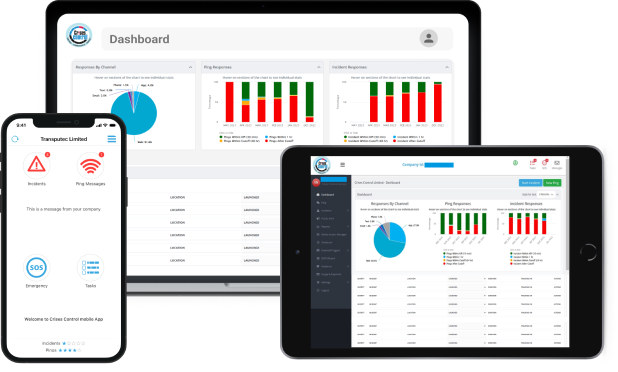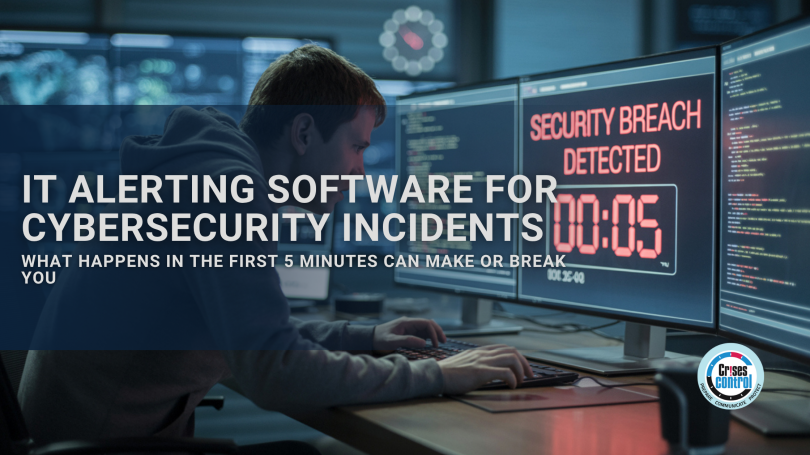Written by Asipe Nokenke | Marketing Assistant
IT alerting software for cybersecurity incidents is your first line of defence when disaster strikes without warning. When a cyberattack hits, there’s no invitation, no countdown, and no bells, just the immediate, high-stakes reality that your systems are under threat and your business continuity is at risk.
In this crucial moment, the first five minutes of your response can define the entire outcome. A modern alerting platform is what empowers you to mobilize your teams, contain the threat, and begin recovery, transforming chaos into a coordinated defence.
Why the First Five Minutes Are Business Critical
The initial 300 seconds after a cyberattack are often misunderstood. It’s not about “fixing everything” at that time. It’s about triggering the right sequence of actions with near-instant speed. A delayed or disorganized response is where damage multiplies.
Here’s what must happen in that critical window:
- Instantaneous Detection and Triage: The moment a credible threat is detected, the clock starts. The right people must be alerted immediately, not just internal IT, but external partners, key executives, and legal teams. Delays cost money, credibility, and legal standing.
- Role-Based Response Activation: Not everyone needs the same information. Your Security Operations Centre (SOC) needs detailed technical logs. Your CISO needs a high-level summary to make strategic decisions. Your legal and communications teams need an early warning to prepare. A proper system delivers context-aware notifications to each group simultaneously.
- Clear Escalation and Acknowledgement: Shouting into the void is not a strategy. You must know who has received the alert and who is taking action. A modern platform tracks message delivery and response in real time, automatically escalating if a key person is unavailable.
- Automated Containment Triggers: Your incident response playbook shouldn’t be a PDF lost on a shared drive. The best cyber incident communication tools can launch containment procedures automatically, such as isolating affected network segments or disabling compromised accounts, based on pre-defined rules.
The Cost of a Delayed Cybersecurity Response
Cyberattacks are not just disruptive, they’re expensive. And the price of hesitation is steep. The average cost of a data breach in the UK is now £3.5 million. What’s more:
- A one-hour delay in response can raise that figure by up to 20%.
- 70% of SMEs that experience a major cyberattack go out of business within six months.
Yet many organisations continue to rely on outdated methods such as group emails, WhatsApp threads, or verbal updates to manage their crisis response.
Why? Often it’s misplaced confidence. The belief that “it won’t happen to us,” or “our IT team can handle it.” But the reality is that even the most skilled teams are powerless without the right tools in place. But even the most capable teams need the right tools to act quickly. And in a crisis where every second counts, being slow isn’t just risky, it’s costly.
What to Look for in an Effective Alerting Platform
Not all alerting platforms are created equal. Many were designed for general emergencies, not the specific, technical, and fast-moving nature of cyberattacks.
When evaluating a solution, look for these non-negotiable features:
- Real-Time, Multichannel Alerts: Attackers don’t work 9-to-5. Your software must be able to reach people instantly on the channels they use: SMS, mobile app push notifications, email, voice calls, and even desktop alerts.
- Two-Way Communication & Acknowledgement: It’s not enough to send an alert. You need to close the loop. The system must track who has received the message, who has acknowledged it, and who has started to act, creating a chain of accountability.
- Automation via Pre-Defined Playbooks: The more you have to think, the more damage the attacker can do. Look for a platform that allows you to build and store an automated response to cyber threats. When a specific incident type is detected, the correct playbook should launch automatically.
- Seamless Integration with Your Security Stack: An alerting platform shouldn’t be an island. It must integrate natively with your SIEM (like Splunk or Microsoft Sentinel), firewalls, and other detection tools to enable instant, trigger-based alerting with zero human delay.
- Immutable Audit Trails: After the incident, you will need to prove what happened and when. Your system must log every message, acknowledgement, and action to provide a complete audit trail for compliance with GDPR, NIS2, and other regulations.
How Crises Control Accelerates Cyber Incident Response
Crises Control was built to remove the delays, silos, and guesswork from emergency communication. Here’s how it specifically supports cybersecurity incident management:
- Immediate Threat Detection Triggers: Via API integrations, Crises Control connects directly with your cybersecurity tools. Once a threat is detected, it can auto-trigger a pre-defined alerting cascade with no human intervention needed.
- Role-Based Communication: A cyberattack is not a one-size-fits-all situation. Crises Control allows you to send tailored communications to different teams, all simultaneously, so that your legal, technical, executive, and customer service teams know exactly what they need to do, right away.
- Secure Mobile Access: No matter where your response teams are, they can receive, acknowledge, and act on alerts from the mobile app. You stay connected and responsive, even out of hours.
- Escalation Management: If someone doesn’t respond in time, the platform escalates automatically, ensuring there’s always someone accountable.
Interested in our Ping Mass Notification Platform?
Efficiently alert everyone in seconds at scale with our Mass Notification Platform – PING, get the message out fast and ensure rapid response and recovery.

What Would a Real Response Look Like?
Scenario: Your firewall flags multiple failed logins from an external IP. Seconds later, your SIEM tool confirms an unauthorised login. This is a live credential stuffing attack.
Without IT alerting software:
- Someone in IT sends a manual email to the team.
- Minutes pass. Key staff are unavailable.
- The breach escalates. Customer data is exfiltrated.
- Legal and PR teams find out too late.
- The media story breaks before your official response is ready.
With Crises Control:
- Your detection tool triggers Crises Control instantly.
- Alerts go to IT, legal, execs, and comms simultaneously via voice, text, email, and app.
- Affected accounts are disabled. External comms are approved and sent within 15 minutes.
- The threat is contained, and your reputation is protected.
That’s the power of automation and speed in real life, not just theory.
Conclusion: Speed Is the Difference Between Recovery and Regret
Cybersecurity incidents are not just IT problems; they are business-critical events with real-world consequences. In those first five minutes after an attack, your organisation needs to act fast, communicate clearly, and coordinate effectively. That’s only possible with the right tools in place.
IT alerting software for cybersecurity incidents is no longer a “nice to have,” it’s an essential part of any serious cyber resilience strategy. When used correctly, it transforms chaos into control, panic into action, and vulnerability into strength.
Crises Control doesn’t just deliver alerts, it delivers assurance. It gives your organisation the confidence to face threats head-on, knowing that every second, every decision, and every person is part of a coordinated defence.
If you’re still relying on email chains, phone trees, or outdated manual processes, it’s time to ask: What would happen if a cyberattack hit right now? If your answer isn’t crystal clear, Crises Control can help you change that.
Don’t let your next cyberattack become a costly headline.
Book a personalised demo with Crises Control today and see how fast, secure, and intelligent your cybersecurity response can be. The first five minutes are ticking, and we’re here to help you own them.
Request a FREE Demo

